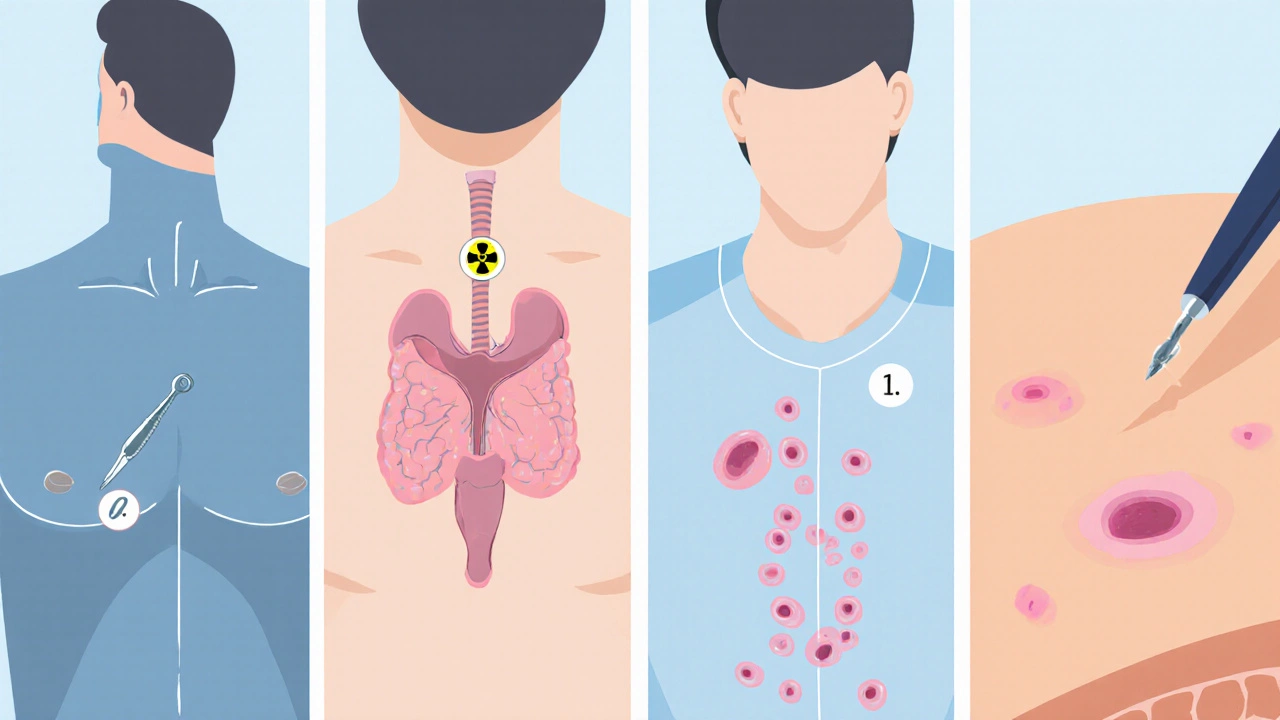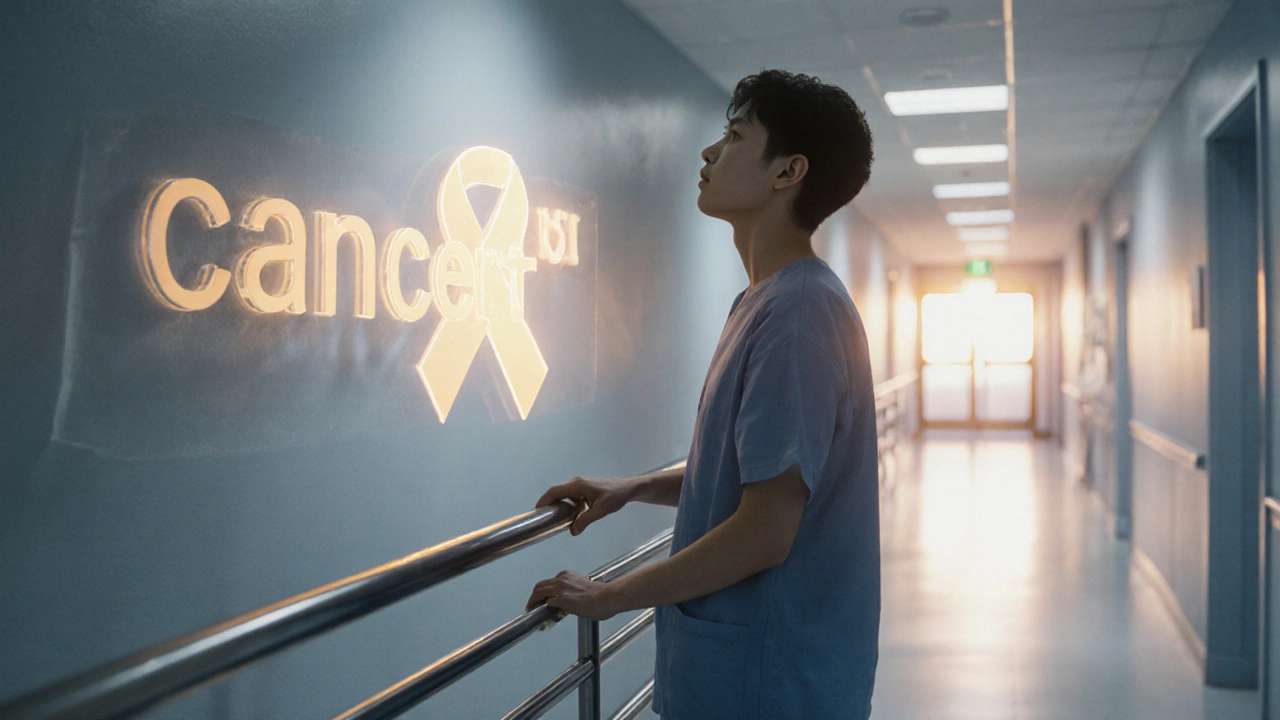Cancer Cure Rate Calculator
Early detection dramatically improves cure rates for certain cancers. This tool estimates your potential cure rate based on cancer type and stage. Remember: most curable cancers require early detection to achieve high cure rates.
Estimated Cure Rate
Your cure rate estimate is based on statistics from the World Health Organization (2024) and national cancer registries.
Why Early Detection Matters
Cancers like testicular and thyroid have cure rates above 95% when caught early. For example, testicular cancer at stage I has a 99% cure rate with surgery alone. Once it spreads (stage III), the cure rate drops significantly.
When you hear the word “cancer,” fear is the first reaction. But not every cancer is a death sentence. Some types boast cure rates that hover at or near100%-provided they’re caught early and treated properly. Below we break down exactly which cancers fit that description, why early detection matters, and what you can do to stay ahead of the game.
Key Takeaways
- Testicular, papillary thyroid, early‑stage Hodgkin lymphoma, and most basal cell skin cancers have cure rates above 95%.
- Early detection and appropriate treatment (usually surgery ± adjunct therapy) are the common threads behind these success stories.
- Regular screening and self‑exams dramatically improve your odds of catching a curable cancer at a stage where it’s fully treatable.
- Even cancers with high cure rates need follow‑up to guard against recurrence.
- Understanding specific cure‑rate statistics helps you make informed decisions about screening and lifestyle.
Cancers That Reach Near‑100% Cure Rates
Below are the major cancer types that, according to the latest data from the World Health Organization (2024) and national cancer registries, achieve cure rates of 95% or higher when diagnosed at an early stage.
Testicular cancer is a malignancy of the male reproductive glands that predominantly affects men aged 15‑40. Modern protocols-often an orchidectomy followed by surveillance, chemotherapy, or radiotherapy-push five‑year survival to 99% for localized disease.
Papillary thyroid carcinoma accounts for about 80% of thyroid cancers. When the tumor is confined to the thyroid (stageI), total thyroidectomy plus radioactive iodine yields a 98‑99% cure rate.
Hodgkin lymphoma (early‑stage, limited‑field) responds exceptionally well to combined chemotherapy (ABVD regimen) and brief radiation, delivering a 95‑98% chance of long‑term remission.
Basal cell carcinoma-the most common skin cancer-has a cure rate exceeding 99% when surgically excised or treated with topical therapies. Its low metastatic potential makes it virtually always curable.
Other cancers that often reach the 90‑95% range (still impressive) include early‑stage melanoma, early‑stage prostate cancer (via active surveillance or surgery), and certain childhood leukemias such as acute lymphoblastic leukemia (ALL) when treated with modern protocols.
Why Early Detection Is the Game‑Changer
The common denominator across the cancers listed above is *stage at diagnosis*. Staging describes how far a tumor has spread; a lower stage means the disease is still confined and easier to eradicate.
For instance, testicular cancer detected while still stageI can be cured with a single surgery. Once it spreads to lymph nodes or lungs (stageII‑III), the cure rate drops to the 70‑80% range, even with aggressive chemotherapy.
Screening tools-self‑exams, imaging, blood markers-enable the detection of tumors before they breach organ boundaries. The earlier you intervene, the more likely a single‑modality treatment (often just surgery) will suffice, avoiding the toxicity of multi‑modal regimens.

Treatment Modalities That Drive High Cure Rates
Understanding how each cancer is tackled helps demystify the statistics.
- Surgery: Removes the primary tumor with clear margins. For testicular, thyroid, and basal cell cancers, surgery alone achieves the highest cure percentages.
- Radiotherapy: Targets residual microscopic disease. In early‑stage Hodgkin lymphoma, a short course of localized radiation after chemo seals the cure.
- Chemotherapy: Systemic drug regimens eradicate cells that have potentially spread. ABVD for Hodgkin lymphoma and platinum‑based combos for testicular cancer are prime examples.
- Targeted therapy & Immunotherapy: Newer agents (e.g., BRAF inhibitors for melanoma) raise cure odds for cancers once considered untreatable.
- Radioactive iodine: Unique to thyroid cancer; it eliminates leftover thyroid tissue post‑surgery, driving survival close to 100%.
Common Misconceptions & Pitfalls
Even with high cure rates, missteps can jeopardize outcomes.
- “If it’s curable, I don’t need follow‑up.” - Recurrence can happen years later, especially for basal cell carcinoma on high‑sun‑exposure areas.
- “Screening isn’t necessary for me because I feel fine.” - Many curable cancers are asymptomatic in early stages. Relying on symptoms alone delays treatment.
- “All skin lesions are harmless.” - While basal cell carcinoma is low risk, squamous cell carcinoma and melanoma require urgent attention.
- “A single negative test means I’m in the clear forever.” - Some cancers, like thyroid, can develop later; periodic reassessment is advised.
Staying Proactive: Screening & Self‑Care Tips
Here’s a practical checklist you can incorporate into your routine.
- Self‑testicular exam monthly for men aged 15‑40. Look for lumps, heaviness, or pain.
- Annual skin check by a dermatologist, especially if you have a history of sunburn or fair skin.
- Thyroid palpation during routine physicals; ask your doctor to order an ultrasound if you notice a nodule.
- Blood work for tumor markers (e.g., AFP, β‑hCG) when risk factors exist.
- Regular imaging (ultrasound, low‑dose CT) for high‑risk groups (family history of testicular cancer, prior radiation exposure).
Combine these actions with a healthy lifestyle-balanced diet, regular exercise, and avoiding tobacco-to reduce overall cancer risk and improve treatment tolerance if a diagnosis occurs.
Quick Reference: Cure‑Rate Comparison Table
| Cancer Type | Typical Stage for High Cure Rate | Primary Treatment Modality | 5‑Year Cure Rate |
|---|---|---|---|
| Testicular (seminoma & non‑seminoma) | StageI | Surgery ± surveillance | 99% |
| Papillary thyroid carcinoma | StageI (confined to thyroid) | Surgery + radioactive iodine | 98‑99% |
| Early‑stage Hodgkin lymphoma | StageI‑II (limited field) | Combination chemo + brief RT | 95‑98% |
| Basal cell carcinoma | Localized skin lesion | Surgical excision / topical therapy | >99% |
| Early‑stage melanoma (≤0.75mm) | Stage0‑I | Wide local excision | ~98% |
Bottom Line: The Promise of Curability
While no cancer can be declared universally “100% curable” for every patient, several types consistently achieve near‑perfect cure rates when caught early. That’s why vigilant screening, prompt medical attention, and adherence to treatment protocols are non‑negotiable. By staying informed and proactive, you dramatically tilt the odds in your favor.
Frequently Asked Questions
Is any cancer truly 100% curable?
No cancer guarantees absolute certainty for every case. However, cancers such as testicular, papillary thyroid, early‑stage Hodgkin lymphoma, and basal cell carcinoma regularly show cure rates above 95%, effectively making them “almost always curable” when diagnosed early.
What does “cure rate” actually mean?
Cure rate usually refers to the percentage of patients who remain disease‑free five years after treatment. It’s a standard benchmark because most recurrences happen within the first five years.
How often should I perform a self‑testicular exam?
Monthly is ideal-pick a consistent day (e.g., the first of each month). Early detection catches up to 90% of testicular cancers while still localized.
Can basal cell carcinoma ever become life‑threatening?
Rarely. Most basal cell cancers grow slowly and rarely metastasize. The danger lies in tissue invasion and cosmetic impact, which is why prompt removal is recommended.
If I’m diagnosed with a curable cancer, do I still need regular follow‑ups?
Yes. Surveillance imaging, blood tests, or physical exams are standard for several years post‑treatment to catch any recurrence early.
